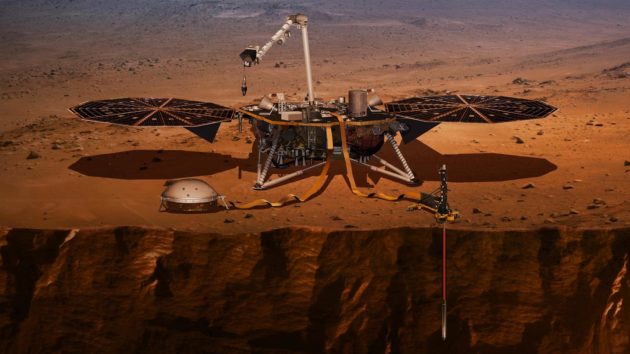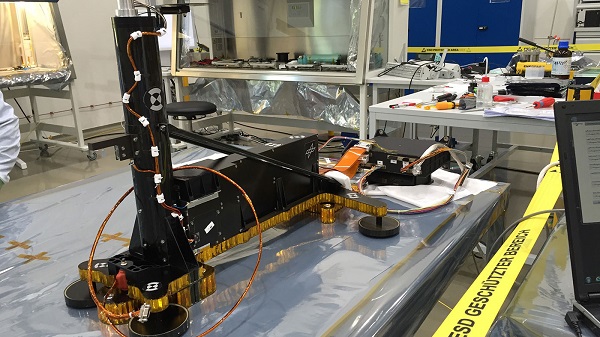Drilling operations for NASA's Mars Insight Lander have been put on hold as the "mole" has hit unexpected obstacles.
Drilling is never easy — especially when you're trying to do it 172 million miles away on another planet. NASA recently announced that its Mars Insight lander will pause drilling operations for about two weeks, following an unexpected stoppage. Engineers think the halt is due to small stones blocking the drill.

NASA / JPL
“The team has decided to pause the hammering for now to allow the situation to be analyzed more closely, and jointly come up with strategies for overcoming to obstacle,” said Tilman Spohn (German Areospace Center) in a recent press release.
The drill is part of Heat Physical Properties Package (HP3) and is designed to bore at least 16 feet (5 meters) down into the Martian regolith to measure the heat emanating from the planet's interior. Provided by the German Aerospace Center (DLR), the drill hammered the Martian soil with 4,000 tiny blows for about 4 hours on its first attempt on February 28th. After about five minutes, it had reached a depth of at least 7 inches but no more than 20 inches (18 to 50 centimeters); subsequent estimates put the drill depth at around 12 inches (30 cm). At this depth, the drill was about three-quarters of the way out of its housing structure. Three and a half hours later, the drill rotated about 15 degrees; it might have encountered a small rock or a layer of gravel and eventually moved around it or pushed it aside.
The drill, also known as the "mole," then stopped to cool down for three days before beginning another hammering session on March 2nd. This time, the drill made no significant progress, which prompted the team to put a hold on further drilling to understand the problem. The team speculates that the mole may have hit another small stone or a layer of gravel.

The Planetary Society / Emily Lakdawalla
Launched from Vandenberg Air Force Base in California on May 5, 2018, along with its Mars Cube One relays, Insight landed on Mars on November 26, 2018. The only mission to make the journey during the biennial Mars launch window, Insight is also the first dedicated geodesy mission designed to probe the interior of Mars.
Scientists had hoped that the regolith around the lander would be relatively stone-free — that's why the team selected the flat, featureless Elysium Planitia landing site for the mission. The mole needs to hit a minimum 3-meter depth for useful science, and the mission team hopes to reach 5 meters. The mole is designed to overcome these brief snags. In fact, DLR engineers put the mole through its paces here on Earth, and it easily deflected small stones and debris placed along its path. However, a rougher regolith will make for slower going than expected.

NASA / JPL-Caltech / DLR
The probe itself is working as expected, measuring heat dissipation and thermal conductivity. This means scientists can calibrate the sensors embedded in the mole's tether. Once the mole has reached 50 cm, the first temperature sensor on the tether will enter the regolith and the instrument will begin to measure heat radiating from the core of Mars itself. Mars's internal warmth is partly leftover from the planet's formation and partly a product of radioactive decay in its interior.
Mars Insight successfully deployed its Seismic Experiment for Interior Structure (SEIS) seismometer, along with its protective bowl-shaped cover, on the Martian surface on December 19, 2018.
Sensing Phobos
Meanwhile, the Mars Insight team is also conducting another interesting observation using the radiometer on the HP3 package. The Martian moon Phobos will transit the Sun several times in early March as seen from Insight's location. The team already managed to "see" the first 30-second event last week, which appeared as a brief dip in temperature of about 1°C on the surface of Mars, much like a lone cloud passing in front of the Sun on a sunny day. This observation is important for measuring the amount of thermal inertia present in the regolith's surface layer. Thermal inertia is a function of density, heat capacity, and thermal conductivity: a small value could reveal porous, low-density regolith, while a larger than expected value could indicate denser regolith. Insight is also expected to detect small land tides raised by the passage of Phobos.
For now, NASA and DLR will discuss strategies to get the drill up and running in the coming weeks. Insight is in good health, and continues to take surface measurements of the Martian environment. There's no need to call in Bruce Willis . . . yet.
 5
5









Comments
Robert-Casey
March 11, 2019 at 4:42 pm
I don't suppose that they could pull it out and try a different spot?
You must be logged in to post a comment.
cmdred
March 13, 2019 at 2:31 pm
InSight was launched from Vandenberg AFB, in California, not Cape Canaveral.
You must be logged in to post a comment.
Monica Young
March 14, 2019 at 11:43 am
Thanks, we've fixed this!
You must be logged in to post a comment.
Mick-Snyder
March 14, 2019 at 11:14 am
16 feet is approx 5m, not 3. Or do you mean 10 feet which is about 3 m?
Later in the article you state the target depth as 50cm. Is this a first target depth for the first temperature sensor? Elsewhere the article implies that the the target depth is 5m (or maybe 3?)
You have me confused!
You must be logged in to post a comment.
Monica Young
March 14, 2019 at 11:43 am
Hi Mick, Thanks for the catch! The target depth is indeed 5 meters, or 16 feet, although the probe can also obtain useful science even if it only reaches 3 meters. The 50 cm mentioned is the depth needed simply for the first sensor to measure the temperature of the regolith rather than the air.
You must be logged in to post a comment.
You must be logged in to post a comment.